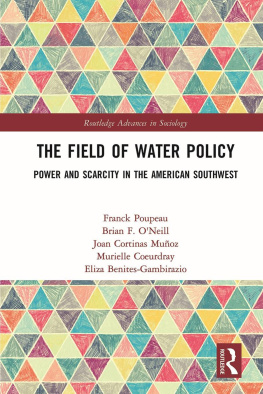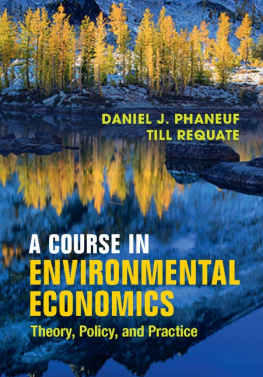Handbook of Environmental Sociology
Riley E. Dunlap, and William Michelson
Westport, CT ; London : Greenwood Press, 2002.
ISBN 0-313-26808-8
Preface
Several years ago we had a vision. It stemmed from the fact that we had both been fortunate to participate in the formative years of Environmental Sociology as it developed in North America in the 1970s. Over the years we have enjoyed an interchange of perspectives, ideas, and empirical results with a number of colleagues who shared our belief that our communities and societies, as well as the field of sociology, could benefit from sociological research focusing on environmental mattersranging from the physical contexts in which we live to the resources on which we depend. Twenty-five years ago sociological interest in such environmental issues was formalized into what is now known as the Section on Environment and Technology within the American Sociological Society (ASA). Our subsequent vision was the creation of a book that captures the range, depth, and complexity of the innovative work being done by environmental sociologists. Although many important works exploring various perspectives and specific kinds of environmental contexts, issues, and problems have been published, we felt the need for a volume which would provide a relatively comprehensive overview of the field of environmental sociology. This volume is the result, and the realization of our vision.
We are grateful to Greenwood Press for its firm support for this vision, and for the numerous people therefrom Mim Vasan to Suzanne Staszak-Silvawho have helped us bring it to fruition.
Our colleagues in the ASA Section encouraged us and cooperated actively in the creation of this volume, charging us with taking editorial responsibilities, but contributing ideas for the content and suggestions for contributors. In addition, numerous colleagues have kindly provided reviews of pre-publication versions of all of the chapters. We are therefore indebted to more environmental sociologists than we could possibly name here. Consequently, we will extend our thanks to the widest range of those who contributed to our vision, while directing specific attention to the many authors of the chapters that follow for their fine efforts in helping us make this volume a reality. In we provide our view of the field and the place of various chapter contributions within it.
We have seen environmental sociology and kindred interdisciplinary subjects grow in size and maturity around the world in recent years, as social science research on environmental topics in general and environmental sociology in particular have clearly become institutionalized. By taking stock of the first quarter century of North American environmental sociology, we hope that this volume will not only help to codify the field, but will also provide guidance to those in the process of extending (and applying) it.
1 Environmental Sociology: An Introduction
Riley E. Dunlap, William Michelson, and Glenn Stalker
This book assembles for the reader a view of the breadth and depth of a recently developing field within sociology called environmental sociology. Twenty-five specialists in this field apply their knowledge and experience to fifteen subsequent chapters, each dealing with a specific topic or sub-area. In this chapter we provide our own appreciation of the substance, range, and progress of environmental sociology, both as a field and as represented by the chapters which follow.
Even the most casual glance at the content and references in these chapters indicates the diversity and richness of sociological work dealing with physical environments. This richness and diversity is also reflected in several book-length introductions to different perspectives on this subject (e.g., Bell, 1998; Harper, 1996; Humphrey and Buttel, 1982; Michelson, 1970/1976; Redclift and Woodgate, 1997), lengthy treatises on a point of view (e.g., Dickens, 1996; Hannigan, 1995; Klausner, 1971; Murphy, 1997; Schnaiberg, 1980; Schnaiberg and Gould, 1994), examinations of uniquely applicable research methods (Bechtel et al., 1990; Finsterbusch et al., 1983; Zeisel, 1981), and seminal articles providing conceptual guidance for the development of an academic field (Buttel, 1987, 1996; Catton and Dunlap, 1978; Dunlap and Catton, 1979, 1983, 1994). A good deal of progress toward integration and consolidation has surely been made; further, various topics have been researched in detail, and most of the major ones are covered in this volume.
We present in this volume our best efforts at a reasonably comprehensive overview of environmental sociology, albeit one with a strong North American focus. Indeed, the volume was stimulated by encouragement from colleagues in the American Sociological Association's (ASA) Section on Environmental Sociology (now the Section on Environment and Technology), and our goal from the outset was to provide-to the extent possible-a state-of-the-art assessment of work in this new field. As a result, this volume is best viewed as an effort to take stock of the first quarter century of environmental sociology in North America. As will be obvious from a comparison of this volume with collections having a more international focus (e.g., Lash et al., 1996; Redclift and Woodgate, 1997; Spaargaren et al., 2000), North American environmental sociology has some distinctive characteristics. On the one hand, it tends to be highly empirical, as the richness of findings reported in the following chapters will demonstrate. On the other hand, it is more preoccupied with the development of mid-range, testable theories than the development of grand, macro-level theories that have been the focus on a good deal of European environmental sociology. In addition, we see a concern with a broader range of environments, from built to natural, in North American environmental sociology than is apparent in international environmental sociology. Such characteristics, which will be touched on later, are neither better nor worse than their counterparts, but they provide environmental sociology in North America a unique orientation that this volume attempts to capture.
Even accomplishing the circumscribed task of presenting a good overview of North American environmental sociology has proven more difficult than imagined, because the field has grown rapidly and new areas of research have taken root and blossomed quickly. For example, when the present volume was originally conceived and chapters solicited, topics such as environmental justice and environmental racism were not nearly as prominent as they are at present, and thus in this volume they are dealt with in the context of chapters focusing on broader issues, such as environmentalism.
The rest of this chapter provides a guide to the field, one which served as the basis for the original selection of chapter topics comprising the book. We shall address environmental sociology's content, foci, boundaries, intellectual perspectives and trends, and current status (the latter internationally as well as in North America). Our original view of these issues helped shape our choice of topics for the chapters that follow; but it is equally true and certainly to be expected that the state of the art which these chapters reveal has come to influence our current assessment of the field.
CONTENT OF THE FIELD
Many specialists in environmental sociology, particularly those who began work in the area when the field was being established, share an experience that shaped their subsequent careers. We discovered that an aspect of the environment which we thought had a real or potential significance for human life was simply not dealt with in any systematic way by then-current sociological knowledge and research. Not only was there a paucity of satisfactory sociological explanation regarding environmental phenomena, but there was a corresponding shortage of perspectives and conceptual schemes needed for investigating such phenomena. Without shared beliefs and intellectual perspectives, it is even more difficult to establish unique methodological tools for empirical investigation.









